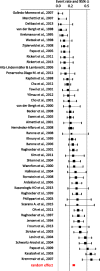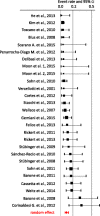Membrane perforation rate in lateral maxillary sinus floor augmentation using conventional rotating instruments and piezoelectric device-a meta-analysis
- PMID: 29376211
- PMCID: PMC5787532
- DOI: 10.1186/s40729-017-0114-2
Membrane perforation rate in lateral maxillary sinus floor augmentation using conventional rotating instruments and piezoelectric device-a meta-analysis
Abstract
Objectives: Maxillary sinus augmentation (MSA) is a successful and predictable intervention with low complication rates. Perforations of the Schneiderian membrane may occur impairing the general success. The aim of this study was to compare the incidence of membrane perforations between conventional rotating instruments and piezoelectric devices in a meta-analysis.
Material and methods: An electronic research on MEDLINE and PubMed database was performed evaluating the literature from 1980 till 2016. Meta-analysis was performed with the studies matching the inclusion criteria. The incidence of perforations between conventional and piezo during the lateral maxillary sinus floor elevation was determined, and forest plots and a t test for significance analysis were performed.
Results: The search provided 377 articles of which 69 could be included. Selected non-randomised and non-controlled prospective and retrospective studies were incorporated. Conventional rotary instruments were associated with a perforation rate of 24%, the piezoelectric devices with 8% with statistically significant difference between both modalities (p < 0.05).
Conclusion: Membrane perforations in MSA may be significantly reduced applying piezoelectrical devices for MSA.
Keywords: Conventional; Perforation; Piezosurgery; Schneiderian membrane; Sinus lift; Ultrasound.
Conflict of interest statement
Competing interests
The authors Jordi Corinne, Mukaddam Khaled, Lambrecht Jörg Thomas and Kühl Sebastian state that they have no competing interests.
Publisher’s Note
Springer Nature remains neutral with regard to jurisdictional claims in published maps and institutional affiliations.
Figures



Similar articles
-
A comparative study of the incidence of Schneiderian membrane perforations during maxillary sinus augmentation with a sonic oscillating handpiece versus a conventional turbine handpiece.Clin Implant Dent Relat Res. 2015 Apr;17(2):327-34. doi: 10.1111/cid.12110. Epub 2013 Jul 9. Clin Implant Dent Relat Res. 2015. PMID: 23837594
-
Membrane perforation in sinus floor elevation - piezoelectric device versus conventional rotary instruments for osteotomy: an experimental study.Clin Implant Dent Relat Res. 2013 Dec;15(6):867-73. doi: 10.1111/j.1708-8208.2012.00447.x. Epub 2012 Feb 29. Clin Implant Dent Relat Res. 2013. PMID: 22376212
-
Piezoelectric bone surgery for lateral sinus floor elevation compared with conventional rotary instruments: A systematic review, meta-analysis and trial sequential analysis.Int J Oral Implantol (Berl). 2020;13(2):109-121. Int J Oral Implantol (Berl). 2020. PMID: 32424379
-
Transcrestal maxillary sinus augmentation: Summers' versus a piezoelectric technique--an experimental cadaver study.Clin Oral Implants Res. 2016 Jan;27(1):126-9. doi: 10.1111/clr.12546. Epub 2015 Feb 16. Clin Oral Implants Res. 2016. PMID: 25682786
-
Anatomical aspects of sinus floor elevations.Clin Oral Implants Res. 2000 Jun;11(3):256-65. doi: 10.1034/j.1600-0501.2000.011003256.x. Clin Oral Implants Res. 2000. PMID: 11168217 Review.
Cited by
-
Effects of Different External Sinus Lifting Techniques on Perioperative Complications and Patient Comfort.Clin Implant Dent Relat Res. 2025 Jun;27(3):e70044. doi: 10.1111/cid.70044. Clin Implant Dent Relat Res. 2025. PMID: 40320286 Free PMC article. Clinical Trial.
-
A Combination of Platelet-Rich Fibrin and Collagen Membranes for Sinus Membrane Repair: A Case Report (Repair of Sinus Membrane Perforation).Dent J (Basel). 2023 Mar 17;11(3):84. doi: 10.3390/dj11030084. Dent J (Basel). 2023. PMID: 36975581 Free PMC article.
-
The Role of Bone Tacks in Sinus Floor Lift Surgery: A Single-Center Experience.J Clin Med. 2024 Jul 29;13(15):4429. doi: 10.3390/jcm13154429. J Clin Med. 2024. PMID: 39124696 Free PMC article.
-
Evolving Techniques and Trends in Maxillary Sinus Lift Procedures in Implant Dentistry: A Review of Contemporary Advances.Cureus. 2024 Oct 14;16(10):e71424. doi: 10.7759/cureus.71424. eCollection 2024 Oct. Cureus. 2024. PMID: 39544602 Free PMC article. Review.
-
Minimally invasive balloon-assisted sinus floor elevation vs. conventional transcrestal procedure in terms of new bone formation in a split-mouth Goettingen minipig model.Int J Implant Dent. 2024 Dec 18;10(1):63. doi: 10.1186/s40729-024-00546-x. Int J Implant Dent. 2024. PMID: 39693009 Free PMC article.
References
-
- Tatum H. Maxillary and sinus implant reconstructions. Dent Clin N Am. 1986;30(2):207–229. - PubMed
-
- Boyne PJ, James RA. Grafting of the maxillary sinus floor with autogenous marrow and bone. J Oral Surg. 1980;38(8):613–616. - PubMed
-
- Khoury F. Augmentation of the sinus floor with mandibular bone block and simultaneous implantation: a 6-year clinical investigation. Int J Oral Maxillofac Implants. 1999;14(4):557–564. - PubMed
Publication types
LinkOut - more resources
Full Text Sources
Other Literature Sources

